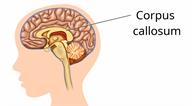Agenesis of the Corpus Callosum, Pediatric

Agenesis of the corpus callosum is a rare brain abnormality. In this condition, part of the brain called the corpus callosum is partially or completely missing. The corpus callosum connects the two sides of the brain (cerebral hemispheres). This condition is present at birth (congenital). It is usually diagnosed within the first 2 years of life.
This condition may occur alone or along with other brain problems or medical conditions. Many children with this condition will lead normal lives. Others may have seizure disorders or problems with development.
What are the causes?
In most cases, the cause of this condition is not known.
A child may have this condition because of abnormal genes that are passed down from parent to child (inherited). The condition can also develop when a woman has an infection or drinks a heavy amount of alcohol while she is pregnant, because those factors can lead to problems in the development of the baby's brain.
What are the signs or symptoms?
Early symptoms of this condition usually include:- Seizures or uncontrollable shaking (convulsions).
- Feeding problems.
- Delays in development. These may include:
- Being unable to hold up one's head.
- Being unable to stand.
- Being unable to sit.
- Being unable to walk.
- Poor mental and physical development.
- Poor hand–eye coordination.
- Poor social development.
- Trouble seeing and hearing.
- Seizures.
- Repetitive speech.
- Headaches.
- Awkward social skills in junior high or high school.
In mild cases, symptoms may not appear for years.
How is this diagnosed?
This condition may be diagnosed:- Before birth, during a routine pregnancy exam. A health care provider can discover the problem using images that are created by sound waves and a computer (ultrasound).
- After birth, using imaging studies such as an MRI, a CT scan, or other brain scans.
How is this treated?
This is a lifelong condition and may require different treatments, depending on your child's symptoms. There is no standard treatment. Treatment usually involves managing symptoms or related conditions.
The condition may be managed with:- Placement of a drainage tube (shunt) in the brain.
- Medicines to control seizures and prevent future seizures.
- Developmental therapies and educational support and services. These are often offered as part of a treatment plan and include:
- Physical therapy. This involves exercise to improve movement, strength, and hand–eye coordination.
- Occupational therapy.
- Speech–language therapy.
- Special education.
Follow these instructions at home:
-
Learn as much as you can about your child's condition.
-
Work closely with your child's health care provider.
-
Give over-the-counter and prescription medicines only as told by your child's health care provider.
-
Have your child do exercises as told by his or her health care provider, if they were prescribed.
-
Keep all follow-up visits. This is important. These include therapy visits, if needed.
Where to find more information
-
National Organization for Disorders of the Corpus Callosum: nodcc.org
Contact a health care provider if:
-
Your child's feeding problems get worse.
-
Your child has more developmental, mental, or physical delays.
-
Your child has more trouble with seeing or hearing.
-
Your child's hand–eye coordination gets worse.
-
Your child's headaches get worse.
-
Your child's speech gets more and more repetitive.
Get help right away if:
-
Your child has a seizure.
-
Your child has trouble breathing.
These symptoms may represent a serious problem that is an emergency. Do not wait to see if the symptoms will go away. Get medical help right away. Call your local emergency services (911 in the U.S.).
Summary
-
Agenesis of the corpus callosum is a rare problem with brain development. It can be diagnosed before birth or during the first 2 years of life.
-
This condition may occur alone or along with other brain problems or medical conditions.
-
Working closely with a health care provider can help ensure that your child receives the therapy and support that he or she needs.
This information is not intended to replace advice given to you by your health care provider. Make sure you discuss any questions you have with your health care provider.

